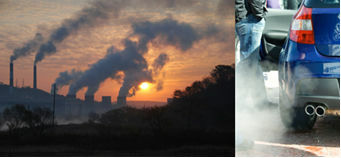The greenhouse effect itself is a natural process that occurs in our atmosphere and which is beneficial as it keeps the planet's temperature mild and without major variations. However, the problem is the exacerbation of this effect, which leads to global warming. To understand how this happens, let's first explain how a greenhouse used by farmers works and then relate it to the Earth's greenhouse effect.
A greenhouse is a closed chamber with transparent glass panel structures used mainly in cold places to grow vegetables and ornamental plants. When the weather is warmer, this structure allows the sun's rays to enter, warming the environment, but preventing this energy goes back to the outside, then retaining the heat, maintaining a favorable temperature for the vegetables to be produced.

Greenhouses allow the retention of heat for growing vegetables
With the Earth a similar process of heat retention takes place, but in a more complex way. Briefly, we can say that the Sun emits radiation in various wavelength ranges, which reach the surface of planet Earth. The surface absorbs about 51% of this radiation and converts and emits the rest in the form of infrared radiation.
When this radiation reaches the atmosphere, some gases that compose it, called greenhouse gases, are able to absorb these radiations and prevent them from returning to space. These gases normally absorb about 19% of solar radiation and help to warm our planet, which would have a temperature around 30°C lower than if there were no such process. In addition, the greenhouse effect maintains the climate without major variations, maintaining life on the planet and enabling various chemical and physical changes to take place.
So, just like in a greenhouse, these gases in the atmosphere trap heat from the sun.

Earth's natural greenhouse scheme
Atmospheric air is composed mostly of nitrogen gases (N2- 78%) and oxygen (O2- 21%), which are not greenhouse gases. The remaining 1% contains various gases and water vapor, with water being largely responsible for the greenhouse effect Natural. The other greenhouse gases are: carbon dioxide (CO2), methane (CH4), nitrous oxide (N2O), chlorofluorocarbons (CFCs), hydrochlorofluorocarbons (HCFCs) and sulfur hexafluoride (SF6).
The problem happens because human beings are releasing more and more greenhouse gases into the atmosphere, and the main villain is carbon dioxide (carbon dioxide - CO2- 0.035%), which is released in the burning of fossil fuels, such as petroleum derivatives (gasoline, diesel oil, etc.) and coal. In addition to CO2, this burning also generates nitrogen oxides, sulfur oxides, hydrocarbons and particulate matter that pollute the atmosphere.

Air pollution from burning fossil fuels increases the concentration of greenhouse gases in the atmosphere
Thus, with a greater concentration of these gases in the atmosphere, a kind of barrier is formed that causes more infrared radiation to be retained and reflected back to the surface. In this way, the greenhouse effect is no longer natural and starts to cause global warming.
Deforestation also releases the aforementioned gases, mainly CO2. Cattle ranching is also responsible for about 50% of the emission of this gas into the atmosphere, as well as methane gas. Chlorofluorocarbons, also called freons, are gases used in refrigerators, air conditioners and sprays, but have been replaced by other gases for some time.
Between the main consequences of the greenhouse effect, we have:
Melting of the polar ice caps, which increases the level of sea water, which is also aggravated by the thermal expansion of the oceanic water mass. This will cause the loss of many coastal ecosystems;
Climate change, that is, while in some regions there is very heavy rain, in others there are great heat waves;
Increase in tropical diseases and proliferation of harmful disease-carrying insects;
Modifications to vegetation in certain places;
The acceleration of chlorophyll function and the increase in CO2 dissolved in the oceans will lead to an increase in terrestrial and oceanic biomass.
By Jennifer Fogaça
Graduated in Chemistry
Source: Brazil School - https://brasilescola.uol.com.br/o-que-e/quimica/o-que-e-um-efeito-estufa.htm
